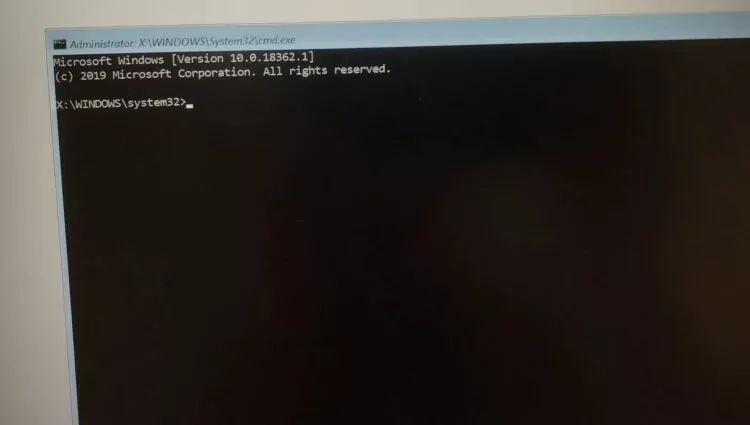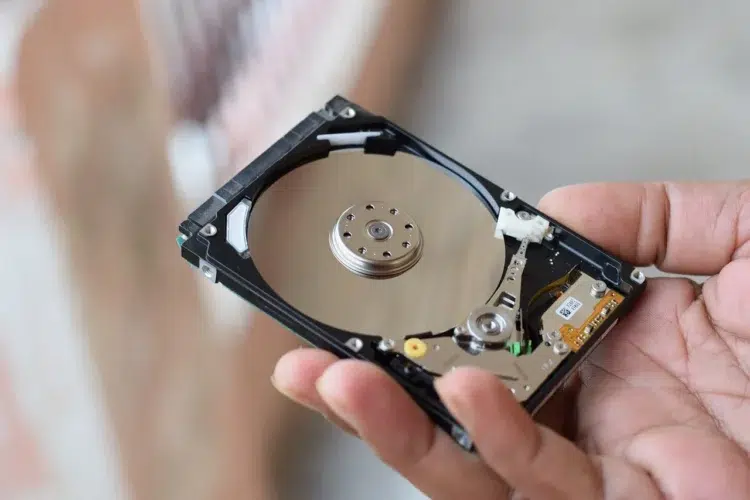Here’s what you should do when you see X:\windows\system32>:
Seeing this when you turn on your computer is a sign that it is not successfully loading Windows.
There are a few possible explanations.
You might be booting your computer from an alternative media, Windows might be corrupted to a point that it can’t load, or you might have a failing hard drive that needs to be replaced.
So if you want to learn what steps to take when you see X:\windows\system32>, then you’re in the right place.
Let’s jump right into it!
What Is X:\\windows\system32>?

When you turn on your computer, and this line greets you instead of your normal Windows startup, there’s something going on that needs to be addressed. Let’s explore why this is happening and how to resolve it.
If you see this unprompted when your computer starts, then there is a problem that needs to be fixed.
To better understand, let’s break down exactly what this means.
The series of letters and numbers is appearing in a command window.
This is a window where you can type direct commands to the computer.
Specifically, this line is letting you know where the commands are currently pointed, and that makes sense if we explore the individual parts.
- X:\\ is a root file path. It’s telling you where the things you are doing are located on the storage drive. By default, C:\\ is the location of your operating system. So, the X you see here is saying that you’re not even in your operating system right now. You’re somewhere else entirely.
- Windows/system32 is the rest of the file path. It’s telling you that you’re in a folder of core Windows files, and specifically, this folder has Windows recovery tools. The tools are designed to help you fix or reinstall Windows, but it’s important to know that not all recovery environments are the same. And, there’s a lot to test to find out whether or not you even need a recovery environment right now.
- > is a designator that is showing it’s the end of the information provided, and you can type commands.
What Should You Do When You See X:\\windows\system32>? (6 Steps)

Considering what you now understand about the file path designation, it’s definitely suboptimal to see this line greeting you when you start your computer.
That’s not a functioning operating system, and if you want to actually use your computer, you’ll need to get past this problem.
Ultimately, there are a few possible things going on, and you can deduce the exact nature of the problem by running through a series of specific steps.
In the worst-case scenario, you’re going to have to reinstall Windows in a way that destroys all of your saved data on the computer. But, let’s not panic just yet. There are multiple possibilities that leave your data intact in the end.
#1 Check for Startup Media
The first thing you want to do is check for alternative startup media.
As you recall, the X:\\ folder doesn’t boot from the same place as your operating system.
That means that your computer has booted from something else, and in many cases, it’s because you have a storage drive other than your main computer drive.
You want to check your computer for any flash drives or other external media, and remove them all.
This includes USB storage drives, DVDs (if you somehow still have one for your computer), and anything else external to the computer that can store information.
It’s also possible that your computer has multiple internal drives.
If you bought your computer pre-made (and it’s not a high-end gaming PC), then you most likely have one internal drive. If your computer is a little more custom, then you might have multiple hard drives.
It’s important to find this out, because the initial goal is to remove any alternative media to ensure that your computer tries to load only from the main drive:
- So, turn off your computer.
- Make sure you completely remove and unplug all extra drives.
- Then, start the computer up again.
If you’re still opening with X:\\, then move on to the next step.
#2 Check Your Boot Settings
As I mentioned before, it’s possible that you have multiple drives inside the computer.
In that case, you’re going to want to turn off all of the drives except the one with Windows.
Even if you have only one internal drive, it’s still possible that it has multiple partitions. Partitions are a way to segregate space on a hard drive (or other storage drive) to protect specific things in the drive.
With Windows machines, it’s not uncommon to have a recovery partition on the main drive. Basically, most of the drive is dedicated to the Windows installation and everything you save in Windows. But, a small part of the drive is portioned off to hold recovery files that can help fix the computer if Windows crashes.
If you have such a recovery drive, then it’s basically like having a second drive in your computer with a recovery partition.
What you are trying to do here is ensure that your computer only boots from the Windows partition and not anything else.
To do that, you need to enter your BIOS. This is an environment that lets you control really fundamental stuff before the operating system loads.
In this case, the specific controls you want are the boot controls. In BIOS, you can tell the computer what drives or partitions it can use to boot, and you can exclude everything else.
To get into BIOS, you’ll want to look up the instructions for your specific build.
Google for your computer brand in combination with “access BIOS.”
For example, your computer brand is Lenovo, then google for “Lenovo access BIOS.”
Each BIOS environment is different, so you’re looking for anything labeled “boot” or “startup.”
Once you find those settings, turn off any boot that isn’t the C: drive.
This will ensure that your computer is trying to load regular old Windows. Once you’ve done this, make sure to save the changes, and restart the computer.
If Windows loads, then you’re good to go. It was just a boot problem, and there’s nothing left to worry about.
If you get the same message, then we’ve now discovered something: Your Windows files are in a state that they cannot be loaded.
It’s not a good place to be, but your data isn’t guaranteed lost just yet.
And, in case you haven’t noticed, I haven’t mentioned anything worse than losing data. That’s because this particular issue is indicating that your computer, other than the main drive, is working normally.
So, you shouldn’t need a whole new computer. You just need to fix Windows.
Regardless, it’s time for the next step.
#3 Run Check Disk

Since your Windows partition is not working correctly, we need to sort out why in order to prescribe the right fix for the problem.
At this point, there could be a hardware failure with your drive. This could still just be a software problem.
We’re about to rule out most software problems.
I told you earlier that you’re actually in a command window right now. You can tell the computer what to do from here, and it wants instructions.
The instructions you’re going to give it will check the drive and Windows installation for major issues.
Actually, you’re going to run three different checks, each related to system files and drive health.
Also, do these in the order I list them for best results.
Here are the steps:
- Type “cd c:\” and press enter. This changes from the X directory to the C directory to try to use your Windows resources. If this doesn’t work, then you can stop. Your drive is inaccessible, and you need a new hard drive. It’s unfortunate, but you found the problem.
- The first real check is run by typing “fixboot c:\” and pressing enter. This specifically looks at startup system files to fix them.
- Next, you want to type “sfc /scannow” and hit enter. This tries to fix all of the major Windows files.
- Last, type “chkdsk /f” and press enter. This will check the disk itself for failure points.
After you run all of these checks, restart the computer.
These processes automatically fix a lot of things, so there’s a reasonable chance that Windows will work now.
If it does, I highly recommend backing up all of your stuff. If this problem can happen once, it can happen again.
But, there’s no harm in continuing to use the computer from here. These processes really can fix a lot of problems.
If your computer restarts to the same X: line, then there are only a few things left to try, and there’s now a good chance that your data will need to be recovered using advanced methods or by taking the drive your local computer shop.
#4 Reinstall Windows
This is a much more drastic step, and it’s only data-safe if you have Windows 10 or 11.
Older versions of Windows can run this step, but the outcomes are very different.
You will lose your data if you do this with older builds of Windows.
That covered, you’re going to reinstall Windows, but you’re going to do it in a way that doesn’t erase all of your personal files.
It will rebuild the Windows systems, and you’ll lose all of your added software.
Even though that sounds bad, you should be able to re-download and reinstall that software.
When you do, all of your personal data will still be preserved. (Assuming that this in fact fixes the computer.)
In that command window, you’re going to type “cd c:\” and press enter to get back to the Windows system.
Then, you’re going to type “C:Windows?System32>restrui.exe” and press enter.
This will fire up the recovery console. In this console, you will have prompts and options. You’re going to follow those options to reinstall Windows.
But, when given the option, you do NOT want to “remove everything.”
By choosing these options, you’ll reset the Windows files and keep your personal data safe.
If your hard drive is functional, then this step has a high probability of success.
When the reinstall is done, the computer will restart itself. If it worked, you now have Windows up and running again.
You’ll have to redo settings that weren’t saved and redownload your missing third-party software, but the computer will work.
If this didn’t work, then you only have two options left, and your data may be lost.
#5 Do a Clean Wipe

This method completely and deliberately erases everything from the drive.
That includes all of your personal data.
The reason to do this is that it’s possible for some non-Windows files to create conflicts that prevent Windows from loading correctly.
So, we’re just ruling that out as a possibility.
The truth is that this isn’t super likely to work.
At this point it’s more likely that your main drive has a physical failure, but it’s always nice to know for sure before you buy new hardware or pay for a repair service.
So, to do a clean wipe, you’re following the same instructions from the previous section, but this time you are going to remove everything.
It might feel like this is deleting your data, but the truth is that your data was inaccessible from the start. It just took the previous steps to be sure.
Once you’ve completed the reinstall, the computer will again restart itself. If Windows loads, then that’s actually good. It means you don’t have to repair or replace anything on your computer.
Losing data is never fun, but losing data and the whole computer is even worse.
If this didn’t work, then all other options have been exhausted.
You need a new main storage drive.
#6 Replace Your Main Drive
The easiest way to replace a storage drive is to take your computer to a technician.
If you are comfortable doing this yourself, feel free.
Physically, replacing a storage drive is fairly easy.
The real challenge is getting a valid license of Windows on the new storage drive.
Legally, you’re allowed to do this without buying a new copy of Windows. It’s just a pain to jump through all of the hoops.
Explaining all of that would make this tutorial even longer, so here’s some extra advice if you’re replacing your drive.


